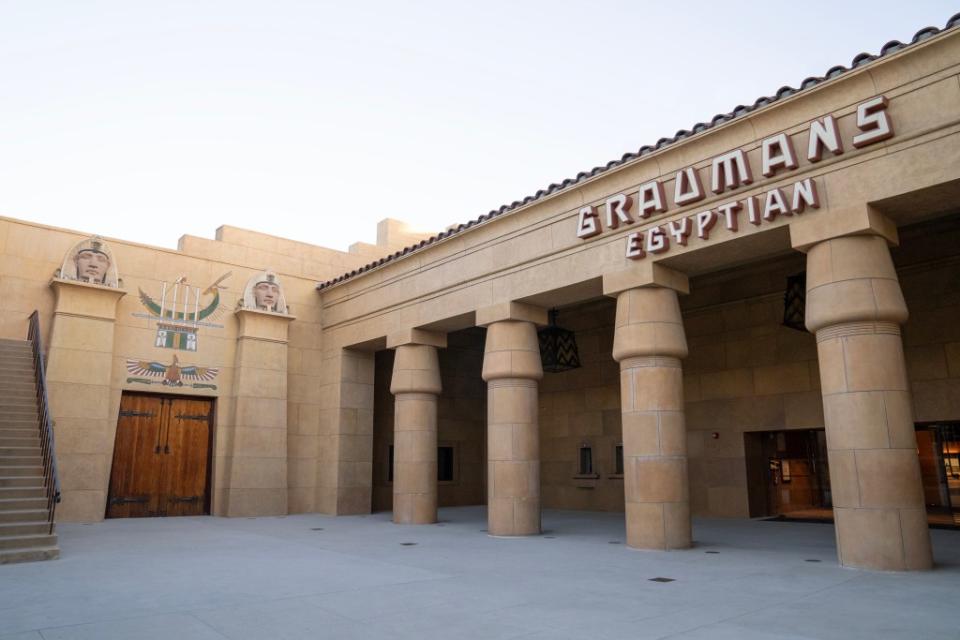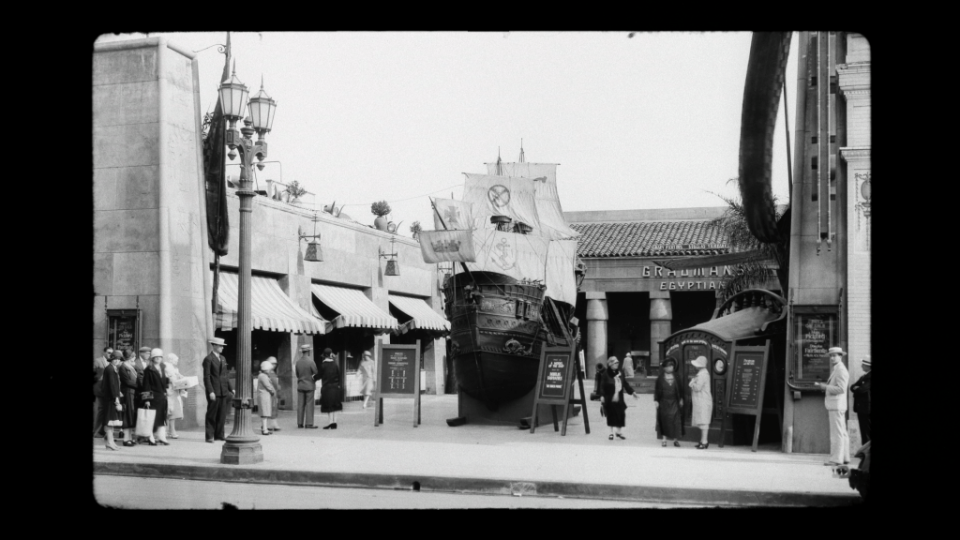Inside Netflix’s Show-Stopping Restoration of Hollywood’s Iconic Egyptian Theater (EXCLUSIVE)
- Oops!Something went wrong.Please try again later.

Hollywood is all about sweeping storytelling, and the tale of the Egyptian Theatre is as stirring as any Golden Age epic. Movie stars, earthquakes, dinosaurs, elephants, hidden tunnels — the Hollywood Boulevard movie palace has seen it all.
Now the theater’s new owner Netflix, along with partner American Cinematheque, is ready to unspool the next reel of its 101-year long career, with a meticulously-executed rebuild. The refurbished theater throws open its doors Nov. 9 with David Fincher’s “The Killer.” More than just a remodeling, the extensive renovations both roll back time to undo earlier modifications and position the 516-seat Hollywood Boulevard theater for the next century of cinema with cutting edge projection, Dolby Atmos sound, flexible lighting and extensive live event capabilities.
More from Variety
Restored Egyptian Theatre Sets November Re-Opening With Netflix's 'The Killer' and David Fincher Q&A
American Cinematheque Awards, Honoring Helen Mirren, Postponed Due to SAG-AFTRA Strike

For Netflix, it’s a way to preserve Hollywood history while providing a splashy roost for film and TV premieres, along with exhibits and live events on weeknights. The streaming giant has already taken over New York’s storied Paris Theater, and it operates the Bay Theater in Pacific Palisades, but the Egyptian was a much bigger undertaking. For the American Cinematheque, which reopened the movie house in 1998 after years of neglect, the partnership allows the film society to keep programming films on weekends without having to worry about fixing leaks and cracks.
“For us, it’s a chance to celebrate our artists and bring the film community together,” says Netflix film chairman Scott Stuber. “We will screen our new films and work with our partners in preservation at the American Cinematheque to show classic films. The Egyptian is a great place for people to fall back in love with the classics, as well as see the great new films we are making. Connecting the old and the new is really important.”
Historic consultant Peyton Hall, who worked on the 1998 remodel, had a touch of déjà vu when he returned to the project. Working with Netflix was a chance to bring a fundamental piece of Hollywood heritage into the 21st century. “The very first meetings with Netflix were all about appreciating the history of Hollywood and cinema and the Egyptian Theatre,” he says. “That sounds good, but you don’t know if it’s true until you see the results of a design.”
Along with Ross Brennan of Studio 440 Architecture, Hall went back to construction drawings from original architects Meyer & Holler and uncovered what impresario Sid Grauman had intended when he built Grauman’s Egyptian Theatre, the first venue to host a Hollywood premiere, “Robin Hood,” in 1922.
One of the fun parts of the work, Hall says, is “looking at photos, newspaper account and interviews with Sid Grauman and weaving together the story of what happened.”
Auditorium upgrade
Certain features needed to be undone, like the balcony that was added in the last renovation. The balcony pushed the location of the projection booth too high, which can cause keystoning, or tilted, distorted images on screen.
“Some of the previous installations were really damaging and had really taken away the character of the theater deeply,” says Brennan.
PHOTOS: The Egyptian Theatre, Then and Now
Not only did the entire foundation need to be rebuilt, a new waterproofing system was created to protect the envelope of the building, while vintage concrete walls were reinforced to modern seismic standards after the building sustained substantial damage in the 1994 earthquake.
In its restored form, the auditorium is filled with hidden innovations and nods to the past.
Most of the lighting is “concealed in coves and behind grills and lattices,” says Brennan. The gray surfaces surrounding the 50-foot screen are made of a sound-absorbing plaster that replaces the former movable panels. Behind the sleek concession stand, discreet pass-through doors camouflage clutter like popcorn machines. The banners and awnings along the walls are historically accurate, but also soak up sound, and the backs of the seats are perforated to cut down on noise.
Even the theater’s centerpiece feature, the elaborate stylized sunburst on the ceiling, conceals air ducts from which organ sounds previously emerged. Moviegoers in the forecourt are unlikely to notice a black bar running across the top of the row of retail spaces, but spotlights can easily be attached to the rod to illuminate big premieres.
Filmgoers might recall that in the previous designs, there were no sound- or light-locks – the lobby doors opened directly into the auditorium. That potentially mood-killing experience has been solved, allowing a reception to continue in the foyer without disturbing the patrons seated in the theater. At the back of the auditorium is a state-of-the-art production booth for capturing live productions, whether awards shows or other performances.
The Egyptian is one of only five theaters in the U.S. that can project highly flammable vintage nitrate films. Safety regulations allow only two nitrate prints to be kept on site at once, and they must be stored in fireproof cabinets with enhanced sprinkler systems in that area. Other projection formats include 35mm, 70mm, plus DCP.
“There will be a nitrate festival announced in the coming months,” promises American Cinematheque artistic director Grant Moninger.
Cinematheque programming
What else can filmgoers expect?
Moninger says, “We’re excited we’re going to open up the Egyptian with a 70mm presentation of Jacques Tati’s ‘Playtime,’ courtesy of Janus.”
The 70mm festival will also feature classics like “2001: A Space Odyssey,” “Lawrence of Arabia,” “The Wild Bunch,” “Aliens,” “West Side Story” and modern films like “The Master,” “Nope” and “Boogie Nights.”
Popular events like Noir City Hollywood will be returning. With the organization continuing to program the Aero in Santa Monica and the Los Feliz Cinema, up to 1500 screenings a year are planned. Also coming up are a screening of the restored “Alphaville” and Edgar Wright will present a screening of “Scott Pilgrim vs. the World” in Dolby Atmos in conjunction with Netflix’s new “Scott Pilgrim Takes Off” anime series.
“We expect new things we’ve never done before, as well as some of the old — lots of Q&As, maybe we’ll revisit live music at some point too,” Moninger says.

Courtyard remodel
Outside the theater, palm tree planters were removed from the spacious forecourt, which can now more easily accommodate red carpets or large-scale events — just like in 1924, when a full-size locomotive was brought in for the premiere of the John Ford epic “The Iron Horse.”
With help from Silverlake Conservation, the large hieroglyphics mural has been restored and brightened up to represent the colors that artists originally chose. Inspired by Egyptian temples, the “door to nowhere” and “staircase to nowhere” to the left of the ticket booths are fully revitalized. Restorers revealed a fresh surface on the other side of the doors when they removed and reversed them.
Throughout the complex are other design touches that might not immediately be noticed, but add to the whole effect, like patterned carpet in the aisles that starts out with light colors and darkens as moviegoers approach the screen, or the ornate original ceiling design in the restrooms.
It’s all about making sure the theater can live on far into the future, says Hall, “We’re in the 21st century, so let’s make really good 21st century architecture and see how we can make that resonate with 1922 architecture.”
Best of Variety
Awards Season Calendar (2023-2024): Key Dates and Timeline for Oscars, DGA, WGA and More
Oscars Predictions: Adapted Screenplay - Is There Room for 'All of Us Strangers?'
Sign up for Variety’s Newsletter. For the latest news, follow us on Facebook, Twitter, and Instagram.

